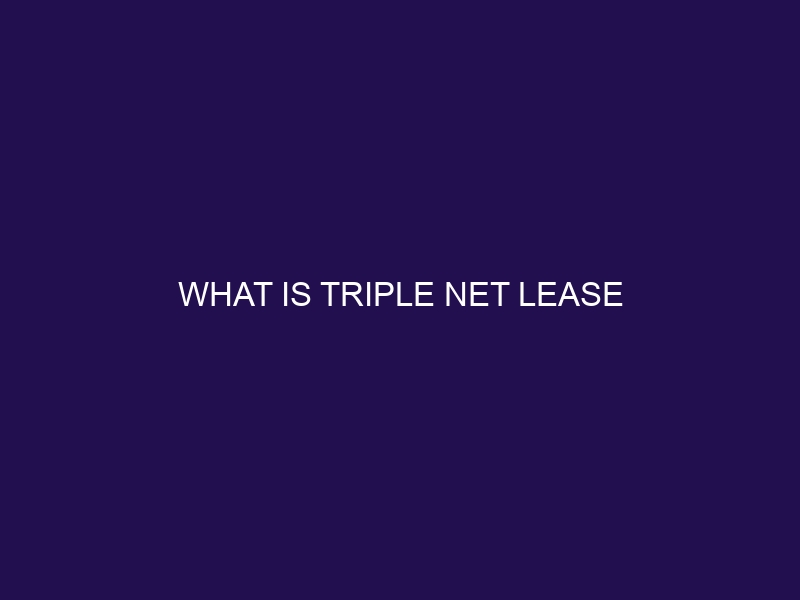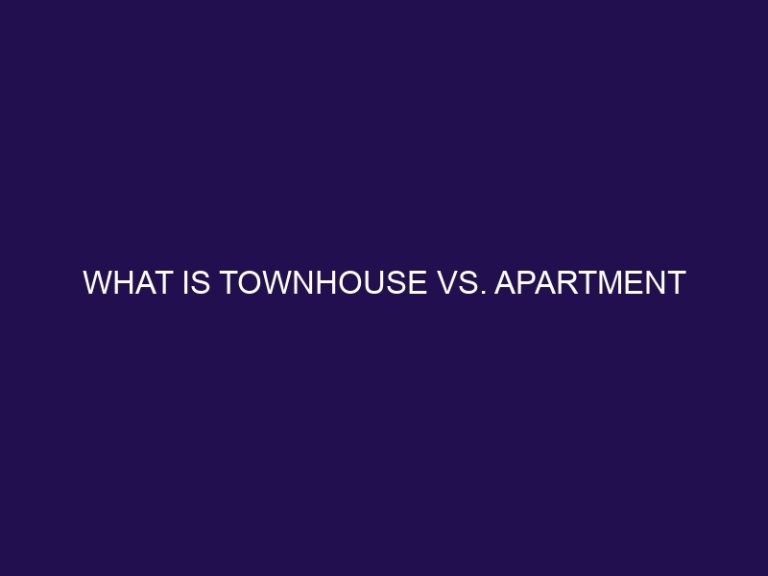What is Triple Net Lease
Triple Net Lease, often abbreviated as NNN lease, is a type of lease agreement that places the majority of financial responsibilities and costs associated with owning a property on the tenant rather than the landlord. It is commonly used in commercial real estate, particularly for retail, industrial, and commercial properties. Understanding the ins and outs of a triple net lease is essential for both landlords and tenants involved in such agreements.
A triple net lease, as the name suggests, requires the tenant to pay for three main expenses in addition to the base rent: property taxes, insurance premiums, and maintenance costs. This means that the tenant assumes financial responsibility for these expenses, relieving the landlord of significant burdens and ensuring a stable rental income for the landlord. The specific terms and details of a triple net lease can vary depending on the negotiation between the parties involved.
In a triple net lease, the tenant is responsible for paying property taxes, which helps offset the costs of local taxes associated with the property. The tenant must cover insurance premiums to protect both the property and the tenant’s business operations. Lastly, the tenant is responsible for maintaining and repairing the property, including any necessary repairs or renovations.
While triple net leases offer benefits to both landlords and tenants, there are also risks and considerations to be aware of. For tenants, the financial risks associated with unexpected increases in property expenses can be a concern. Property management challenges and potential for increased operating costs should be carefully evaluated. Landlords, on the other hand, benefit from reduced financial responsibility, stable and predictable income, and the ability to attract long-term tenants.
Triple net leases find applications in various industries and property types. Commercial properties, retail spaces, and industrial properties commonly utilize triple net leases due to the shared responsibilities and cost allocation between the landlord and tenant.
Understanding the concept, workings, benefits, and considerations of triple net leases is crucial for anyone involved in the commercial real estate sector. By ensuring clear and detailed agreements, both landlords and tenants can navigate this lease structure successfully and establish mutually beneficial arrangements.
Understanding Triple Net Lease
Understanding triple net lease is crucial for both tenants and landlords. It is important to comprehend the following key points:
- Definition: A triple net lease refers to a commercial lease agreement where the tenant assumes responsibility for paying the net expenses, including property taxes, insurance, and maintenance.
- Tenant Benefits: Triple net leases offer tenants greater control over the property and can lead to reduced rent payments.
- Landlord Benefits: Landlords enjoy the advantages of reduced operational costs and minimal involvement in property management.
- Lease Terms: Triple net leases generally have longer terms, providing stability for both tenants and landlords.
- Risk: Tenants should carefully assess the financial implications and potential risks associated with a triple net lease.
When considering a triple net lease, it is advisable to seek legal advice, thoroughly understand the terms, and evaluate the condition and location of the property.
What is a Triple Net Lease?
Curious about triple net leases? Dive into what a triple net lease entails, with a focus on its definition and explanation. Get ready to unravel the intricacies of this widely used leasing arrangement and gain a solid understanding of its implications. Buckle up as we explore the ins and outs of triple net leases and demystify this key aspect of commercial real estate.
Definition and Explanation of Triple Net Lease
A triple net lease, also known as a NNN lease, is a type of lease agreement in which the tenant is responsible for paying not only the rent but also the property’s operating expenses, including taxes, insurance, and maintenance costs. This arrangement shifts a significant portion of financial responsibility from the landlord to the tenant. Triple net leases are commonly used in commercial real estate, especially for properties like retail stores, industrial buildings, and office spaces.
By understanding the definition and explanation of a triple net lease, both landlords and tenants can determine if this type of lease is suitable for their needs. Landlords benefit from reduced financial responsibility and predictable income, while tenants enjoy flexibility. Potential risks include financial burdens for tenants, property management challenges, and the potential for increased operating costs.
A triple net lease offers advantages and risks for both parties involved. It is important to carefully consider the terms and conditions before entering into such an agreement.
To ensure a beneficial outcome, it is crucial for both parties to thoroughly review the terms and conditions before entering into a triple net lease agreement.
How Does a Triple Net Lease Work?
Interested in knowing how a triple net lease actually works? In this section, we’ll uncover the nitty-gritty details of this leasing arrangement. From understanding the responsibilities of the tenant to the obligations of the landlord, we’ll unravel the dynamics that make a triple net lease a unique contractual agreement. Get ready to dive into the inner workings of this type of lease and gain a comprehensive understanding of its mechanics.
Responsibilities of the Tenant
Responsibilities of the Tenant
When entering into a triple net lease agreement, tenants have specific responsibilities that they must fulfill throughout the lease term:
- Payment of rent: The tenant is responsible for paying the agreed-upon rental amount on time.
- Property maintenance: Tenants must maintain the leased property, including routine repairs and upkeep.
- Tax obligations: Tenants are typically responsible for paying property taxes associated with their leased space.
- Insurance: It is the tenant’s responsibility to obtain and maintain appropriate insurance coverage for the leased property.
- Compliance with regulations: Tenants must comply with all applicable laws, regulations, and zoning requirements.
By fulfilling these responsibilities of the tenant, tenants contribute to a smooth and successful triple net lease arrangement.
Responsibilities of the Landlord
The responsibilities of the landlord in a triple net lease are crucial for maintaining the property and ensuring a smooth lease agreement. Here are some key responsibilities that landlords typically have:
- Landlords are responsible for the overall maintenance and repairs of the property, including structural repairs, HVAC systems, and landscaping.
- Landlords are responsible for maintaining insurance coverage on the property, as well as paying property taxes.
- Landlords are responsible for the upkeep of common areas, such as parking lots, hallways, and elevators.
- Landlords are responsible for enforcing lease terms, collecting rent, and addressing any lease violations.
- Landlords are responsible for providing financial reports to tenants and keeping accurate records of income and expenses related to the property.
By fulfilling these responsibilities, landlords can ensure a well-functioning triple net lease and maintain a positive relationship with their tenants.
Benefits of Triple Net Leases
Looking into the benefits of triple net leases, we uncover a world of advantages for both landlords and tenants. From reduced financial responsibility that lightens the load for landlords, to stable and predictable income that brings peace of mind. Not to mention the flexibility it offers tenants. Let’s dive deeper into these sub-sections to understand the true value of triple net leases in the real estate market.
1. Reduced Financial Responsibility for the Landlord
- One of the advantages of a triple net lease is that it reduces the financial responsibility for the landlord. This means that the tenant is responsible for property maintenance, repairs, and renovations, resulting in lower maintenance costs for the landlord.
- In addition, by entering into a triple net lease, the landlord can avoid unexpected costs as the tenant takes on the responsibility of paying property taxes, insurance premiums, and operating expenses. This leads to predictable expenses for the landlord.
- Moreover, a triple net lease provides the landlord with stable cash flow. With a fixed annual rental income, the landlord can confidently plan their finances without worrying about fluctuating expenses.
2. Stable and Predictable Income for the Landlord
A triple net lease offers several advantages by providing stable and predictable income for landlords. With this type of lease, the tenant assumes financial responsibility by paying for the property’s operating expenses, such as property taxes, insurance, and maintenance costs. This arrangement helps ease the financial burden on the landlord and ensures reduced financial responsibility. Additionally, the lease typically spans a long duration, resulting in stable income through consistent rental payments. By minimizing income fluctuations, landlords can rely on a steady and predictable stream of revenue. Moreover, because the tenant is accountable for property expenses, landlords can accurately forecast their outgoings and plan accordingly, leading to predictable expenses. With tenants taking care of property maintenance, landlords can adopt a more hands-off approach, reducing their involvement in day-to-day operations and providing an opportunity for lower management involvement. The stable and predictable income provided by a triple net lease is beneficial for landlords in multiple ways.
3. Flexibility for the Tenant
Flexibility for the tenant is a major advantage of triple net leases. Here are some ways in which tenants benefit from this flexibility:
- Adaptability: Tenants have the freedom to customize their space according to their specific needs and requirements.
- Expansion or downsizing: Tenants can easily adjust the size of their leased space as their business needs change.
- Renewal options: Tenants have the flexibility to negotiate lease renewals and extend their lease terms if desired.
- Subleasing opportunities: In some cases, tenants have the ability to sublease their space to other businesses, providing additional income or helping to offset costs.
The concept of flexibility for tenants in commercial leases dates back centuries. In medieval Europe, merchants rented stalls and booths on a temporary basis, allowing them the freedom to move locations and adapt to changing market demands. This tenant-friendly approach continues to be valued in modern triple net leases, providing businesses with the flexibility they need for long-term success.
Risks and Considerations of Triple Net Leases
Navigating the world of triple net leases can be a daunting task, especially when it comes to understanding the risks and considerations involved. In this section, we’ll delve into the different aspects that tenants should be aware of. From financial risks to property management challenges, we’ll explore the potential pitfalls that might arise. We’ll examine the potential for increased operating costs and how this can impact the overall viability of a triple net lease agreement. So buckle up and let’s dive into the intricate world of triple net lease risks!
1. Financial Risks for the Tenant
Financial risks for the tenant in a triple net lease can vary depending on the specific terms of the lease agreement. Here are a few potential risks to consider:
- 1. The tenant may face financial risks as they are responsible for paying their share of property taxes, insurance, and maintenance costs. If these expenses unexpectedly increase, it can strain the tenant’s finances.
- 2. There is a risk of vacancy where the tenant may still be obligated to pay rent and other expenses even if they are unable to find a subtenant or if their business struggles, and the property remains vacant.
- 3. The tenant may face unexpected costs in the form of repairs and renovations if the lease requires them to undertake significant repairs or renovations, which can impact their financial stability.
- 4. Market fluctuations can be a risk as well. If the rental market in the area declines, the tenant may find it challenging to find new tenants or renegotiate the lease terms, potentially affecting their financial position.
2. Property Management Challenges for the Tenant
Handling the management of a property under a triple net lease can bring forth a multitude of challenges for tenants. These challenges primarily revolve around maintaining the property, dealing with repairs, and effectively managing day-to-day operational expenses. It becomes imperative for tenants to strategically allocate resources to ensure regular upkeep and keep the property in optimal condition. Additionally, tenants have the responsibility of promptly resolving any unforeseen repair or maintenance issues that may arise over the course of the lease. It is also essential for tenants to closely monitor and control various operating costs such as utilities, insurance, property taxes, and fees related to common area maintenance. By successfully navigating these hurdles, tenants can fulfill their obligations under a triple net lease in an efficient and effective manner.
3. Potential for Increased Operating Costs
A potential drawback of triple net leases is the potential for increased operating costs for tenants. These costs can impact their overall profitability and financial stability.
| Factors contributing to increased operating costs: |
| 1. Maintenance and repairs |
| 2. Property taxes |
| 3. Insurance premiums |
| 4. Utilities |
| 5. Common area maintenance fees |
To mitigate these costs, tenants should carefully review lease terms, negotiate caps on certain expenses, and assess potential risks before entering into a triple net lease agreement.
Examples and Applications of Triple Net Leases
When it comes to triple net leases, examples and applications are key to understanding how this type of lease structure works. In this section, we’ll dive into various settings where triple net leases are commonly utilized. From commercial properties to retail and industrial spaces, we’ll explore real-life scenarios that illustrate the practicality and advantages of this lease arrangement. So, get ready to uncover the diverse applications of triple net leases and how they are shaping the real estate landscape.
1. Commercial Properties
- When considering investing, commercial properties provide numerous advantages, including long-term tenants, stable income, and the possibility of appreciation.
- Here are some factors to consider when examining commercial properties:
- Location: Opt for properties located in high-demand areas with good accessibility and a high volume of foot traffic.
- Tenant mix: Assess the current tenant base to ensure a diverse range of businesses, thereby minimizing risk.
- Lease terms: Evaluate the duration and conditions of existing leases to gauge the stability of rental income.
- Property condition: Conduct a thorough inspection of the property to identify any necessary repairs or maintenance that could impact its value.
- Market analysis: Research local market trends, vacancy rates, and rental rates to assess the property’s potential for generating income.
2. Retail Properties
In the realm of retail properties, triple net leases are frequently utilized. These leases transfer significant responsibilities to the tenant, encompassing property taxes, insurance, and maintenance costs, in addition to the base rent. This arrangement proves advantageous for landlords as it alleviates their financial burden and guarantees a steady income without the hassle of property management. Meanwhile, tenants benefit from the flexibility to personalize the space and exert control over operational costs. However, it is important to be aware of the associated risks, such as potential financial burdens for tenants and challenges in property management. Notable examples of retail properties that commonly embrace triple net leases include shopping centers, standalone stores, and strip malls.
3. Industrial Properties
Industrial properties are commonly utilized in triple net lease agreements. These properties, such as warehouses, manufacturing facilities, and distribution centers, among others, fall under the category of industrial properties. With a triple net lease, the tenant assumes responsibility for not only rent but also the property’s operating expenses, including property taxes, insurance, and maintenance costs. This arrangement benefits both parties, as the tenant gains flexibility in customizing the space, while the landlord experiences reduced financial responsibility and a steady income stream. It is important for tenants to consider the potential challenges of managing industrial properties, which may include property maintenance and the possibility of increases in operating costs. Examples of industrial properties that are commonly leased under triple net agreements include factories and logistics hubs.
Frequently Asked Questions
What is a triple net lease?
A triple net lease, also known as a NNN lease, is a common lease structure in commercial real estate where the tenant is responsible for paying taxes, property insurance, and operating expenses in addition to the base rent and utilities. This includes costs such as repairs, maintenance, trash removal, landscaping, parking lot maintenance, and property management.
What are the benefits of a triple net lease for tenants?
Triple net leases offer tenants more freedom to customize the space without the need for a large capital investment. They also provide the potential to negotiate lower rents and possible tax benefits. NNN leases often come with protections against tax and insurance increases through the use of caps.
Why are triple net leases attractive to landlords?
Triple net leases provide a reliable source of income for landlords with minimal overhead costs. They offer a low-risk investment opportunity and allow property owners to transfer financial responsibilities to the tenant. Landlords can also benefit from the potential for long-term occupants and stable cash flow.
What are the common lengths of triple net leases?
Triple net leases are typically long-term, with durations of 10 or 15 years being common, but they can be even longer. The specific length of the lease depends on the agreement between the landlord and tenant.
What costs are included in the “nets” of a triple net lease?
A triple net lease divides costs into three “nets”: property taxes, insurance, and operating expenses. Operating expenses, also known as common area maintenance (CAM), include repairs, maintenance, trash removal, landscaping, and more. Depending on the property, utilities and janitorial services may also be included.
Should I hire a real estate attorney to review a triple net lease?
Yes, it is highly recommended to hire a qualified real estate attorney to review any lease or purchase contract, especially for triple net leases. Different lease structures heavily favor the landlord, and a real estate attorney can help ensure your best interests are protected and clarify the terms and conditions of the lease agreement.




